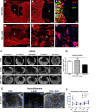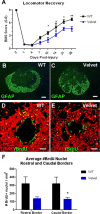Transforming growth factor α transforms astrocytes to a growth-supportive phenotype after spinal cord injury
- PMID: 22016551
- PMCID: PMC3213757
- DOI: 10.1523/JNEUROSCI.3441-11.2011
Transforming growth factor α transforms astrocytes to a growth-supportive phenotype after spinal cord injury
Abstract
Astrocytes are both detrimental and beneficial for repair and recovery after spinal cord injury (SCI). These dynamic cells are primary contributors to the growth-inhibitory glial scar, yet they are also neuroprotective and can form growth-supportive bridges on which axons traverse. We have shown that intrathecal administration of transforming growth factor α (TGFα) to the contused mouse spinal cord can enhance astrocyte infiltration and axonal growth within the injury site, but the mechanisms of these effects are not well understood. The present studies demonstrate that the epidermal growth factor receptor (EGFR) is upregulated primarily by astrocytes and glial progenitors early after SCI. TGFα directly activates the EGFR on these cells in vitro, inducing their proliferation, migration, and transformation to a phenotype that supports robust neurite outgrowth. Overexpression of TGFα in vivo by intraparenchymal adeno-associated virus injection adjacent to the injury site enhances cell proliferation, alters astrocyte distribution, and facilitates increased axonal penetration at the rostral lesion border. To determine whether endogenous EGFR activation is required after injury, SCI was also performed on Velvet (C57BL/6J-Egfr(Vel)/J) mice, a mutant strain with defective EGFR activity. The affected mice exhibited malformed glial borders, larger lesions, and impaired recovery of function, indicating that intrinsic EGFR activation is necessary for neuroprotection and normal glial scar formation after SCI. By further stimulating precursor proliferation and modifying glial activation to promote a growth-permissive environment, controlled stimulation of EGFR at the lesion border may be considered in the context of future strategies to enhance endogenous cellular repair after injury.
Figures









Similar articles
-
Nucleolin inhibitor GroA triggers reduction in epidermal growth factor receptor activation: Pharmacological implication for glial scarring after spinal cord injury.J Neurochem. 2016 Sep;138(6):845-58. doi: 10.1111/jnc.13730. Epub 2016 Aug 1. J Neurochem. 2016. PMID: 27399849
-
TGF-alpha increases astrocyte invasion and promotes axonal growth into the lesion following spinal cord injury in mice.Exp Neurol. 2008 Nov;214(1):10-24. doi: 10.1016/j.expneurol.2008.06.012. Epub 2008 Jul 2. Exp Neurol. 2008. PMID: 18647603 Free PMC article.
-
Proliferating NG2-Cell-Dependent Angiogenesis and Scar Formation Alter Axon Growth and Functional Recovery After Spinal Cord Injury in Mice.J Neurosci. 2018 Feb 7;38(6):1366-1382. doi: 10.1523/JNEUROSCI.3953-16.2017. Epub 2017 Dec 26. J Neurosci. 2018. PMID: 29279310 Free PMC article.
-
Don't fence me in: harnessing the beneficial roles of astrocytes for spinal cord repair.Restor Neurol Neurosci. 2008;26(2-3):197-214. Restor Neurol Neurosci. 2008. PMID: 18820411 Free PMC article. Review.
-
Axon regeneration after spinal cord injury: insight from genetically modified mouse models.Restor Neurol Neurosci. 2008;26(2-3):175-82. Restor Neurol Neurosci. 2008. PMID: 18820409 Free PMC article. Review.
Cited by
-
Role of melatonin in traumatic brain injury and spinal cord injury.ScientificWorldJournal. 2014;2014:586270. doi: 10.1155/2014/586270. Epub 2014 Dec 21. ScientificWorldJournal. 2014. PMID: 25587567 Free PMC article. Review.
-
Up-regulation of Smurf1 after spinal cord injury in adult rats.J Mol Histol. 2013 Aug;44(4):381-90. doi: 10.1007/s10735-013-9499-2. Epub 2013 Apr 18. J Mol Histol. 2013. PMID: 23595775
-
Functional regeneration beyond the glial scar.Exp Neurol. 2014 Mar;253:197-207. doi: 10.1016/j.expneurol.2013.12.024. Epub 2014 Jan 11. Exp Neurol. 2014. PMID: 24424280 Free PMC article. Review.
-
NEUROD1 Instructs Neuronal Conversion in Non-Reactive Astrocytes.Stem Cell Reports. 2017 Jun 6;8(6):1506-1515. doi: 10.1016/j.stemcr.2017.04.013. Epub 2017 May 11. Stem Cell Reports. 2017. PMID: 28506534 Free PMC article.
-
Receptor tyrosine kinase (RTK) signalling in the control of neural stem and progenitor cell (NSPC) development.Mol Neurobiol. 2014 Feb;49(1):440-71. doi: 10.1007/s12035-013-8532-5. Epub 2013 Aug 28. Mol Neurobiol. 2014. PMID: 23982746 Review.
References
-
- Ahmed Z, Jacques SJ, Berry M, Logan A. Epidermal growth factor receptor inhibitors promote CNS axon growth through off-target effects on glia. Neurobiol Dis. 2009;36:142–150. - PubMed
-
- Aimone JB, Leasure JL, Perreau VM, Thallmair M. Spatial and temporal gene expression profiling of the contused rat spinal cord. Exp Neurol. 2004;189:204–221. - PubMed
-
- Anchan RM, Reh TA, Angello J, Balliet A, Walker M. EGF and TGF-alpha stimulate retinal neuroepithelial cell proliferation in vitro. Neuron. 1991;6:923–936. - PubMed
-
- Barry D, McDermott K. Differentiation of radial glia from radial precursor cells and transformation into astrocytes in the developing rat spinal cord. Glia. 2005;50:187–197. - PubMed
-
- Basso DM, Fisher LC, Anderson AJ, Jakeman LB, McTigue DM, Popovich PG. Basso Mouse Scale for locomotion detects differences in recovery after spinal cord injury in five common mouse strains. J Neurotrauma. 2006;23:635–659. - PubMed
Publication types
MeSH terms
Substances
Grants and funding
LinkOut - more resources
Full Text Sources
Medical
Molecular Biology Databases
Research Materials
Miscellaneous
